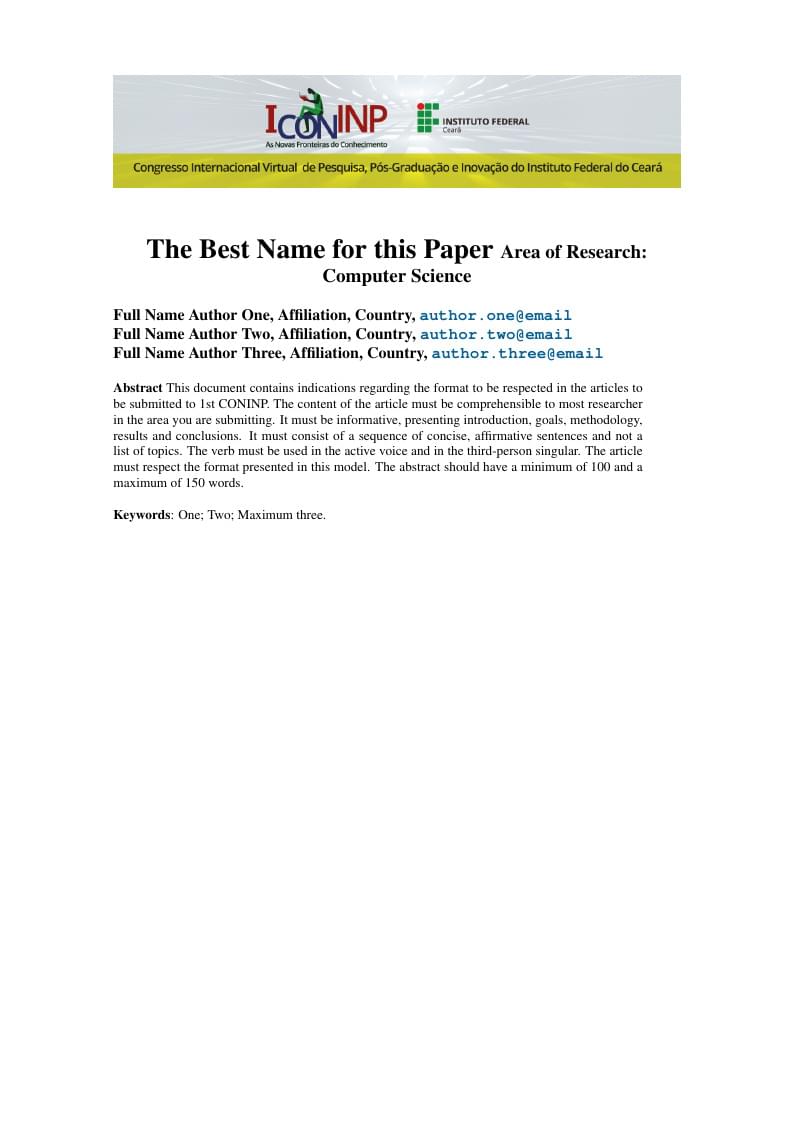
CONINP IFCE
Author:
Antonio Wendell de Oliveira Rodrigues
Last Updated:
5 years ago
License:
Creative Commons CC BY 4.0
Abstract:
Template for CONINP Congress

\begin
Discover why over 20 million people worldwide trust Overleaf with their work.
Template for CONINP Congress

\begin
Discover why over 20 million people worldwide trust Overleaf with their work.
\documentclass{coninp}
\makeatletter
\setlength{\@fptop}{0pt}
\makeatother
%%%%%%%%%%%%%%%%%%%%%%%%%%%%%%%%%%%%
% BEGIN DOCUMENT
%%%%%%%%%%%%%%%%%%%%%%%%%%%%%%%%%%%%
\begin{document}
%% Header Image on 1st page Don't modify
\begin{figure}[t!]
\centering
\includegraphics[keepaspectratio, width=1\textwidth]{media/TopHeader1.png}
\end{figure}
\hfill
\hfill
%%
\selectlanguage{english}
%%%%%%%%%%%%%%%%%%%%%%%%%%%%%%%%%%%%
% FRONT MATTER
%%%%%%%%%%%%%%%%%%%%%%%%%%%%%%%%%%%%
% ARTICLE TITLE
\title{The Best Name for this Paper} % Appears on title page
\areaofresearch{Computer Science}
\author{
\bf{Full Name Author One}, Affiliation, Country, \email{author.one@email}
\and
\bf{Full Name Author Two}, Affiliation, Country, \email{author.two@email}
\and
\bf{Full Name Author Three}, Affiliation, Country, \email{author.three@email}
}
\maketitle
% ABSTRACT
\begin{abstract}
\textbf{Abstract}
This document contains indications regarding the format to be respected in the articles to be submitted to 1st CONINP. The content of the article must be comprehensible to most researcher in the area you are submitting. It must be informative, presenting introduction, goals, methodology, results and conclusions. It must consist of a sequence of concise, affirmative sentences and not a list of topics. The verb must be used in the active voice and in the third-person singular. The article must respect the format presented in this model. The abstract should have a minimum of 100 and a maximum of 150 words.\\\\
\textbf{Keywords}: One; Two; Maximum three.
\end{abstract}
\newpage
%% Header Image on 1st page Don't modify
\begin{figure}[t!]
\centering
\includegraphics[keepaspectratio, width=1\textwidth]{media/TopHeader1.png}
\end{figure}
\hfill
\hfill
%%
\author{
}
\maketitle %again without identification
% ABSTRACT
\begin{abstract}
\textbf{Abstract}
This document contains indications regarding the format to be respected in the articles to be submitted to 1st CONINP. The content of the article must be comprehensible to most researcher in the area you are submitting. It must be informative, presenting introduction, goals, methodology, results and conclusions. It must consist of a sequence of concise, affirmative sentences and not a list of topics. The verb must be used in the active voice and in the third-person singular. The article must respect the format presented in this model. The abstract should have a minimum of 100 and a maximum of 150 words.\\\\
\textbf{Keywords}: One; Two; Maximum three.
\end{abstract}
%%%%%%%%%%%%%%%%%%%%%%%%%%%%%%%%%%%%
% END OF FRONT MATTER
%%%%%%%%%%%%%%%%%%%%%%%%%%%%%%%%%%%%
%%%%%%%%%%%%%%%%%%%%%%%%%%%%%%%%%%%%
% DOCUMENT MAIN SECTIONS
%%%%%%%%%%%%%%%%%%%%%%%%%%%%%%%%%%%%
\newpage
\section{Introduction}\label{sec-intro}
Articles submitted to 1st CONINP must respect the format described in this document.
All articles will be subject to a double blind review process, so when submitting the article on the platform for evaluation it cannot contain any reference that identifies the authors. To do so, they must create two cover pages, the first (Face Page 1) with the indication of the authors and the second (Face Page 2) like the first one, without identifying the authors. The first cover sheet will not be computed for the total pages.
The following sections describe the recommended dimensions and formats for submission to the congress.
This document is formatted according to the rules defined for the congress, so it can and should be used as a model for the construction of the article.
For citations you can do as the following \lstinline[language=TeX]/\cite{markowitz52,rockafellar02,rockafellar06}/ produces \cite{markowitz52,rockafellar02,rockafellar06}.
\subsection{Format and pages}
The articles must be developed in A4 format (210 by 297 mm), measuring the upper and left margins: 3 cm, lower and right: 2 cm.
Full papers must have a minimum of 10 and a maximum of 12 pages.
\section{Work Structure}
\subsection{Introduction}
\subsection{Methodology}
\subsection{Results and Discussion}
\subsection{Conclusion}
\subsection{References}
\hfill
\section{Methodology}
In this section you should discuss the methodology.\footnote{Footnote links should come after punctuation.}
In this edition, citations and bibliographic references, as well as their formatting, must follow: Works from Brazil follow the Norms of ABNT 2020 (https://www.normasabnt.org/) and works from other countries follow the guidelines APA (American Psychological Association), 6th edition.
\subsection{Figures}
See Figure \ref{fig1}.
\begin{figure}[t]
\begin{center}
\caption{A figure}\label{fig1}
\includegraphics{media/plot.pdf}
\end{center}
\end{figure}
\subsection{The model}
We write inline equations as \(x=x\) or displayed equations as
\begin{equation}\label{eq1}
\mathrm dX_t = \mu\mathrm dt + \sigma\mathrm dB_t
\end{equation}
and reference equations using \lstinline[language=TeX]/\eqref{eq1}/ to display as equation \eqref{eq1}.
\begin{definition}
We say that \textbf{$x$ is equal to $x$} whenever $x=x$.
\end{definition}
\section{Presenting approved works}
The authors have a maximum of 10 (ten) minutes to present their articles in the virtual rooms, designated by the Organizing Committee. The president of virtual room has instructions to strictly enforce this rule. There are also 5 minutes in each presentation for discussion between the audience and the authors.
The presentations must be prepared in PDF format.
Accepted articles will be published in full in the electronic ANNALS of the event and, therefore, the pages should not be numbered.
\section{Results}
You can add tables easily: see \autoref{tab1}. There are three custom column types that accept width specification: \lstinline[]/L/, \lstinline[]/C/ and \lstinline[]/R/, which work similarly to the standard \lstinline[]/p/ column type; for instance, use \lstinline[]/C{4cm}/ for a (horizontally) centered column 4cm wide.
\begin{table}[ht]
\begin{center}
\scalefont{0.9}
\caption{A simple table}\label{tab1}
\begin{tabular}{L{15em}C{5em}c}
\toprule
variable & value & $p$-value\tabularnewline
\midrule
$X$ & 1 & 0.0 \tabularnewline\addlinespace[5pt]
$Y$ & $-1$ & 0.8\tabularnewline
\midrule
{You can write long texts inside\newline table cells, with custom linebreaks} & A & B\tabularnewline
\bottomrule
\end{tabular}
\end{center}
\end{table}
\subsection{Some additional features}
Table~\ref{tab2} illustrates how to align numbers by the decimal place marker. It also shows how to implement the \lstinline[]/\multirow/ command.
\begin{table}[ht]
\begin{center}
\scalefont{0.9}
\caption{Another simple table}\label{tab2}
\begin{tabular}{L{4em}L{4em}r@{.}lc}
\toprule
variable & & \multicolumn{2}{c}{value} & $p$-value\tabularnewline
\midrule
$X$ & & 1&001 & 0.0 \tabularnewline\addlinespace[5pt]
$Y$ & & $-10$&00 & 0.8\tabularnewline\midrule
\multirow{2}{*}{$Z$} & $Z_1$ & 1&1 & 0\tabularnewline
& $Z_2$ & 2&2 & 0\tabularnewline
\bottomrule
\end{tabular}
\end{center}
\end{table}
Here are two useful tools to help formatting \LaTeX\ tables:
\begin{enumerate}[label = (\roman*), itemsep=0pt]
\item \url{https://www.tablesgenerator.com}
\item \url{https://truben.no/table/}
\end{enumerate}
%%%%%%%%%%%%%%%%%%%%%%%%%%%%%%%%%%%%
% END OF DOCUMENT MAIN SECTIONS
%%%%%%%%%%%%%%%%%%%%%%%%%%%%%%%%%%%%
%%%%%%%%%%%%%%%%%%%%%%%%%%%%%%%%%%%%
% ACKNOWLEDGEMENTS
%%%%%%%%%%%%%%%%%%%%%%%%%%%%%%%%%%%%
\section*{Acknowledgments}
Author One would like to thank Institution One for financial support.
%%%%%%%%%%%%%%%%%%%%%%%%%%%%%%%%%%%%
% END OF ACKNOWLEDGEMENTS
%%%%%%%%%%%%%%%%%%%%%%%%%%%%%%%%%%%%
%%%%%%%%%%%%%%%%%%%%%%%%%%%%%%%%%%%%
% REFERENCES
%%%%%%%%%%%%%%%%%%%%%%%%%%%%%%%%%%%%
\bibliography{references.bib}
\bibliographystyle{apacite}
%%%%%%%%%%%%%%%%%%%%%%%%%%%%%%%%%%%%
% END OF REFERENCES
%%%%%%%%%%%%%%%%%%%%%%%%%%%%%%%%%%%%
%%%%%%%%%%%%%%%%%%%%%%%%%%%%%%%%%%%%
% END OF DOCUMENT
%%%%%%%%%%%%%%%%%%%%%%%%%%%%%%%%%%%%
\end{document}